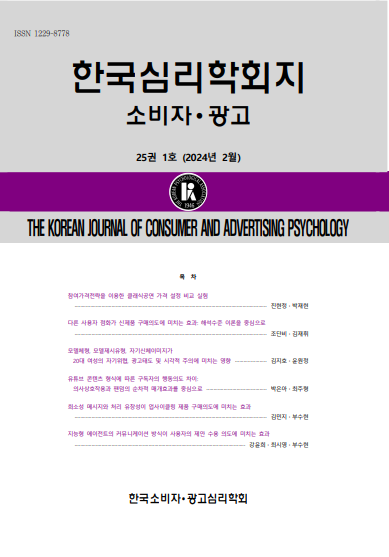open access
메뉴.png)
open access
메뉴 ISSN : 1229-8778
ISSN : 1229-8778
Among the many decisions made throughout the day is not only for myself, but also for others. In the same situation, however, who is the beneficiary of the decision may affect the outcome of the decision. This study is to examine how the decision beneficiary affect the decision process. In particular, the effect of decision object and construal levels on risk-taking. In addition, it was intended to examine the effect of choice accountability on the decision maker by comparing it with the decision maker's accountability to explain its decision to the beneficiary of the decision. In this study, the effect of decision object and construal levels on risk-taking levels has been examined. Each participant was randomly assigned to one of six conditions in the experimental of 3(decision object: self/other with accountability/ without accountability) X 2(construal level: high/low) 2-way completely randomized factorial design. The result shows an effect of correlation between decision object and construal level, and represents that participants who have low-construal prefer to select low risk-taking choices when the decisions are made for self and for other with responsibility, whereas participants who have high-construal reveal not much difference. Although it is very common to decide whether to take or avoid risks in various circumstances, this study focuses on consumers' decision making upon purchase. Especially, a decision making procedure upon purchasing items for oneself or for others has been investigated with the consideration of the others classified by detailed characteristics. The research results implicate that people have a tendency to take higher risks for the choices for others than for themselves but the tendency diminishes when they feel accountabilities. Through the measurement of construal levels, it has been identified that individuals' variable also has an influence on the results.
김경욱 (2010). 특성불안과 시간거리 지각이 대안의 선호도에 미치는 영향: 해석정도가론에 근거하여. 한국심리학회지: 일반, 29(4), 659-678.
박현정 (2014). 질병 예방 행동 촉진을 위한 커뮤니케이션 메시지 전략 연구: 자궁경부암에서 심리적 거리, 해석수준, 이득-손실 프레임을 중심으로. 한국언론학보, 58(3), 344-377.
Atanasov, P. D. (2010). Double Risk Aversion. <http://ssm.com/abstract>
Beisswanger, A. H., Stone, E. R., Hupp, J. M., & Allgaier, L. (2003). Risk taking in relationships: Differences in deciding for oneself versus for a friend. Basic and Applied Social Psychology, 25(2), 121-135.
Botti, S., Orfali, K., & Iyengar, S. (2009). Tragic choices: Autonomy and emotional responses to medical decisions. Journal of Consumer Research, 36, 337-352.
Danziger, S., & Montal, R., & Barkan, R. (2012). Idealistic advice and pragmatic choice: A psychological distance account. Journal of Personality and Social Psychology, 102(6), 1105-1117.
Fischhoff, B. (1992). Giving advice: Decision theory perspectives on sexual assault. American Psychologist, 47, 577-88.
Hamilton, R. W., & Biehal, G. (2005). Achieving Your Goals or Protecting Their future? The Effects of Self- View on Goals and Choices. Journal of Consumer Research, 32, 277-283.
Kray, L. (2000). Contingent weighting in self-other decision making. Organizational Behavior and Human Decision Processes, 83(1), 82-106.
Kray, L., & Gonzalez, R. (1999). Differential weighting in choice versus advice: I’ll do this, you do that. Journal of Behavioral Decision Making, 12, 207-217.
Laran, J. (2010). Goal management in sequential choices: Consumer choices for others are more indulgent than personal choices. Journal of Consumer Research, 37(2), 304-314.
Lermer, E., Streicher, B., Sachs, R., Raue, M., & Frey, D. (2014). The effect of construal level on risk-taking. European Journal of Social Psychology, Eur. J. Soc. Psychol.
Lerner, J., & Tetlock, P. (1999). Accounting for the effects of accountability. Psychological Bulletin, 125, 255-275.
Loewenstein, G., E. U. Weber, C. K. Hsee, E. S. Welch. 2001. Risk as feelings. Psych. Bull, 127, 267-286.
Mandel, N. (2003). Shifting selves and decision making: The effects of self-construal priming on consumer risk-taking. Journal of Consumer Research, 30(1), 30-40.
Pollmann, M. H., Potters, J., & Trautmannb, S. T. (2014). Risk taking by agents: The role of ex-ante and ex-post accountability. Economics Letters, 123, 387-390.
Polman, E. (2010). Information distortion in self-other decision making. Journal of Experimental Social Psychology, 46, 432-435.
Polman, E. (2012). Self-other decision making and loss aversion. Organizational Behavior and Human Decision Processes, 119, 141-150.
Polman, E. (2012). Effects of self-ther decision making on regulatory focus and choice overload. Journal of Personality and Social Psychology. 102(5), 980-993.
Polman, E., & Emich, K. J. (2011). Decisions for others are more creative than decisions for the self. Personality and Social Psychology Bulletin, 37, 492-501.
Tversky, A., & Kahneman, D. (1981). The framing of decisions and the psychology of choice. Science, 211, 453-458.
Vallacher, R. R., & Wegner, D. M. (1989). Levels of personal agency: Individual variation in action identification. Journal of Personality and Social Psychology, 57(4), 660-671.
Van Boven, L., & G. Loewenstein, G. (2003). Social projection of transient drive states. Psych. Bull, 29(9), 1159-1168.
Van Boven, L., & Loewenstein, G. (2005). Cross-situational projection. The Self in Social Judgment, Psychology Press, 43-64.
Van Boven, L., Loewenstein, G., & Dunning, D. (2003), Mispredicting the endowment effect: Underestimation of owners’ selling prices by buyer’s agents. Journal of Economic Behavior and Organization, 51(3), 351-65.
